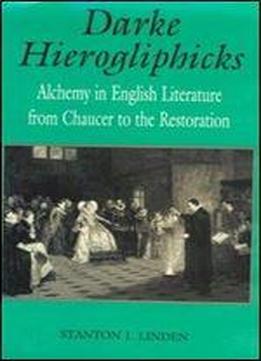
Darke Hierogliphicks: Alchemy In English Literature From Chaucer To The Restoration
by Stanton J. Linden /
2018 / English / PDF
51.6 MB Download
The literary influence of alchemy and hermeticism in the work of most medieval and early modern authors has been overlooked. Stanton Linden now provides the first comprehensive examination of this influence on English literature from the late Middle Ages through the sixteenth and seventeenth centuries. Drawing extensively on alchemical allusions as well as on the practical and theoretical background of the art and its pictorial tradition, Linden demonstrates the pervasiveness of t in alchemy during this three-hundred-year period. Most writersincluding Langland, Gower, Barclay, Eramus, Sidney, Greene, Lyly, and Shakespearewere familiar with alchemy, and references to it appear in a wide range of genres. Yet the purposes it served in literature from Chaucer through Jonson were narrowly satirical. In literature of the seventeenth century, especially in the poetry of Donne, Herbert, Vaughan, and Milton, the functions of alchemy changed. Focusing on Bacon, Donne, Herbert, Vaughan, and Miltonin addition to Jonson and ButlerLinden demonstrates the emergence of new attitudes and innovative themes, motifs, images, and ideas. The use of alchemy to suggest spiritual growth and change, purification, regeneration, and millenarian ideas reflected important new emphases in alchemical, medical, and occultist writing. This new tradition did not continue, however, and Butler's return to satire was contextualized in the antagonism of the Royal Society and religious Latitudinarians to philosophical enthusiasm and the occult. Butler, like Shadwell and Swift, expanded the range of satirical victims to include experimental scientists as well as occult charlatans. The literary uses of alchemy thus reveal the changing intellectual milieus of three centuries.











